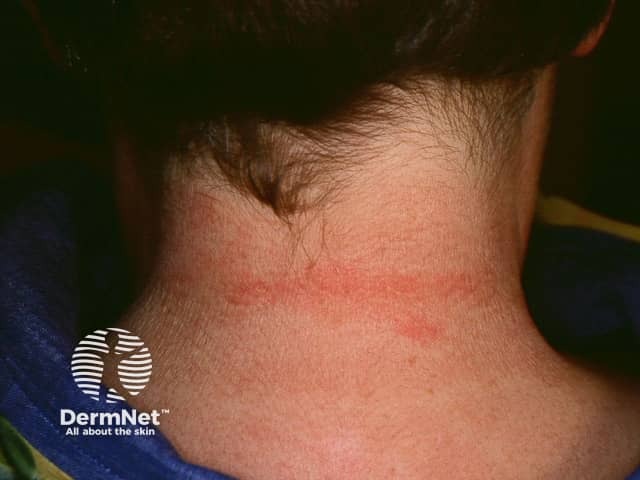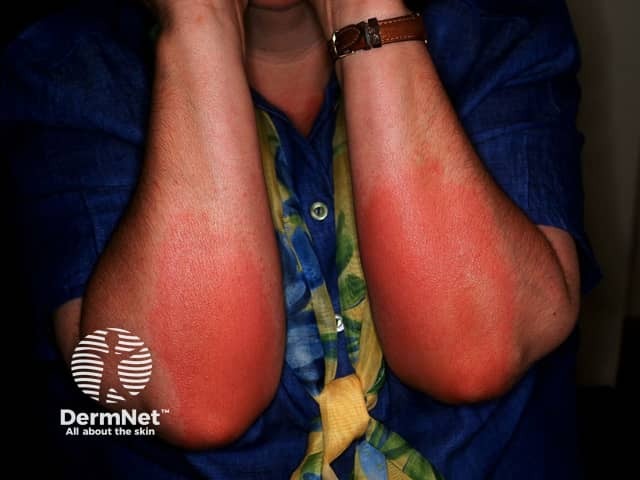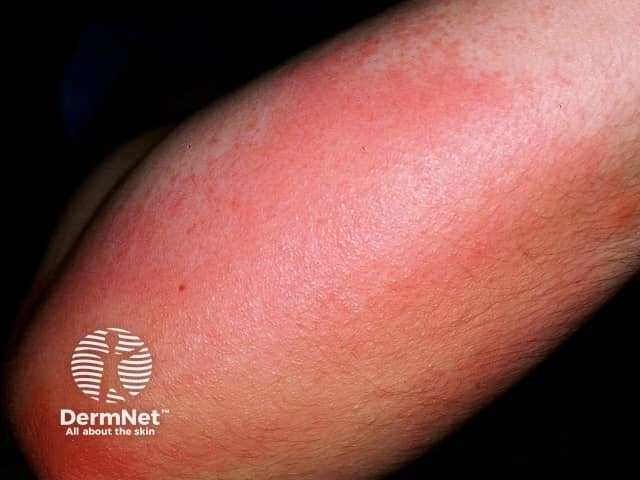Main menu
Common skin conditions

NEWS
Join DermNet PRO
Read more
Quick links
Delayed pressure urticaria — extra information
Delayed pressure urticaria
Author: Dr Mark Duffill, Dermatologist, Hamilton, New Zealand, 2008.
What is pressure urticaria?
Pressure urticaria is a form of chronic inducible urticaria characterised by the appearance of weals and/or angioedema after pressure to the skin.
- Pressure urticaria may occur immediately after a pressure stimulus or more commonly, in delayed pressure urticaria, after a delay of 4–6 hours.
- Lesions can be induced by a variety of stimuli including standing, walking, wearing tight clothes or sitting on a hard surface.
- Pressure urticaria can occasionally be aggravated by heat, aspirin or menstruation.
Pressure urticaria is uncommon but probably not rare. It is a chronic disease with a mean duration of 9 years. The peak age of onset is in the 20s and 30s. It is also called delayed-pressure urticaria/angioedema.

Pressure urticaria

Pressure urticaria

Pressure urticaria
What are the symptoms of pressure urticaria?
The weal in pressure urticaria consists of redness and swelling of the skin and subcutaneous tissues. Lesions may last for 8–72 hours.
- The hands, feet, trunk, buttocks, legs and face are most commonly affected.
- Weals may be accompanied by fever, malaise, fatigue, and occasionally chills, headache and general joint aches.
- Affected areas may be resistant to the development of new lesions for 1-2 days.
- Up to 60% of patients with pressure urticaria also have chronic urticaria, immediate and/or delayed dermographism, and/or angioedema.
Pressure urticaria has a significant adverse impact on the quality of life of patients, with important limitations in everyday activities such as prolonged walking or standing. It can be disabling in patients who perform manual labour.
What is the cause of delayed pressure urticaria?
The cause of pressure urticaria is unclear but it is likely to be an autoimmune disease. Cells called mast cells are an important part in the process. Mast cells are tissue cells that contain chemicals, including histamine, which provoke wealing.
What investigations should be done in delayed pressure urticaria?
The diagnosis of delayed pressure urticaria is made clinically. It can be confirmed if a delayed weal occurs after a standardised pressure stimulus. This is often painful. In immediate pressure urticaria, a weal will appear within minutes of the stimulus.
A blood count may show an increased white cell count and ESR, but it is often normal.
A skin biopsy of delayed pressure urticaria shows inflammatory infiltrates which vary with the age of the weal. No vasculitis is found.
Management of delayed pressure urticaria
The results of treatment of pressure urticaria are relatively disappointing.
- Reduce pressure stimuli as far as practicable.
- Antihistamines help control associated chronic urticaria but rarely reduce pressure urticaria.
- The ultrapotent topical corticosteroid clobetasol propionate may reduce inflammation. Skin thinning can result from regular use. Milder topical steroids are not of benefit.
- Systemic corticosteroids produce variable responses and long-term use is associated with many potential adverse side effects.
- Other possible therapies include nonsteroidal anti-inflammatory drugs (NSAIDs), colchicine, dapsone, sulfasalazine and montelukast.
- Ciclosporin, methotrexate and intravenous gamma globulin have been used in a small number of patients with severe and refractory disease.
- Tumour necrosis factor-alpha inhibitors have been reported of benefit in a few patients.
References
- Joslyn Sciacca-Kirby, MD, Staff Physician, Dept of Dermatology, Hospital of the University of Pennsylvania. eMedicine. Dermatology. Allergy and Immunology. Pressure Urticaria.
- Lawlor F, Kobza Black A. Delayed pressure urticaria. Immunol Allergy Clin North Am 2004; 24:247–58. PubMed
